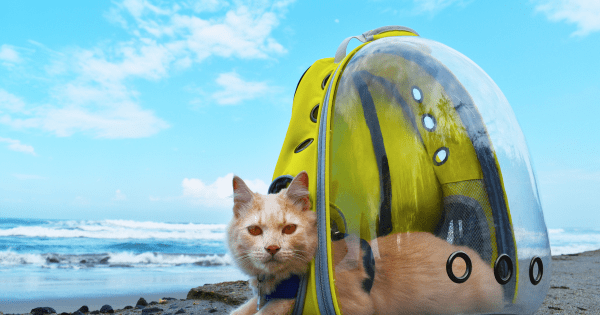Traveling with a cat can seem like a daunting experience for both pet owners and their feline companions. Unlike dogs, cats tend to be creatures of habit and may not enjoy leaving the comfort of their familiar surroundings. However, with proper preparation and the right approach, you can make traveling with your cat a stress-free experience. Whether you’re planning a short trip to the vet or a long-distance vacation, this guide will provide essential tips to ensure that both you and your cat have a smooth journey.

Why Traveling with Your Cat Requires Special Attention
Cats are generally more sensitive to changes in their environment compared to other pets, especially dogs. While some cats may adapt well to new surroundings, many experience anxiety when taken out of their comfort zone. Changes in routine, unfamiliar sights, sounds, and smells can all contribute to a cat’s stress levels, making travel challenging. That’s why it’s important to take extra care when traveling with your cat and prepare thoroughly for the journey.
Preparing for the Trip
Preparation is key to reducing stress and ensuring a successful trip with your cat. By planning ahead and making the necessary arrangements, you can help minimize your cat’s anxiety and make the journey as comfortable as possible.
1. Choose the Right Carrier
One of the most important steps in preparing for a trip with your cat is selecting the right carrier. A good-quality carrier will provide your cat with a safe, enclosed space that feels secure. When choosing a carrier, consider the following:
- Size and Comfort: The carrier should be large enough for your cat to stand, turn around, and lie down comfortably, but not so big that your cat feels unprotected.
- Ventilation and Visibility: Look for a carrier with plenty of ventilation so your cat can breathe easily. Some cats prefer carriers with a lot of visibility, while others might feel safer with more privacy. You can cover the carrier with a blanket if your cat prefers less visibility.
- Secure and Sturdy: Ensure the carrier is well-constructed with secure latches. A flimsy or weak carrier could break open during travel, leading to a dangerous situation for your cat.

2. Familiarize Your Cat with the Carrier
Many cats associate their carrier with stressful trips to the vet, which can make them anxious as soon as they see it. To avoid this, it’s important to familiarize your cat with the carrier before the trip. Here are a few tips:
- Leave the Carrier Out: A week or more before the trip, leave the carrier out in a common area of your home. Encourage your cat to explore it by placing treats, toys, or a comfortable blanket inside.
- Positive Reinforcement: Give your cat treats or praise when they enter the carrier voluntarily. This will help them associate the carrier with positive experiences rather than just trips to the vet.
- Short Practice Trips: Before embarking on a long journey, take your cat on short trips around the neighborhood to get them used to being in the carrier and traveling in the car.
3. Pack the Essentials
Before hitting the road, make sure you have everything your cat needs for the trip. Here’s a checklist of essential items to bring:
- Food and Water: Pack your cat’s regular food and a supply of water. Portable food and water bowls are also helpful for on-the-go feeding.
- Litter Box: For long trips, especially overnight ones, you’ll need a portable litter box and a supply of litter. There are compact, disposable litter boxes available for travel.
- Comfort Items: Bring along your cat’s favorite blanket, toys, or anything that smells like home. Familiar scents can help reduce anxiety.
- Treats and Medications: If your cat takes regular medication, make sure to bring enough for the duration of the trip. Treats can also be useful for rewarding good behavior and easing stress during the journey.

Traveling by Car
Car travel is one of the most common methods of transporting cats. While it might be simpler than air travel, car rides can still be stressful for cats. Here are some tips to make the experience smoother:
1. Secure the Carrier in the Car
Always secure the carrier in a stable position, such as on the backseat, and use the seatbelt to strap it in. Avoid placing the carrier in the front seat, especially if your car has airbags, as the deployment of an airbag could harm your cat.
2. Keep the Car Calm and Quiet
Cats are sensitive to loud noises and sudden movements. During the trip, try to maintain a calm and quiet environment. Avoid playing loud music or making abrupt stops. You might want to play soft, soothing music to help your cat relax during the drive.
3. Take Breaks for Long Trips
If you’re going on a long road trip, make sure to schedule breaks to check on your cat. During these breaks, offer water, a small amount of food, and give your cat a chance to use the litter box if necessary. However, avoid opening the carrier outside, as a scared cat may try to escape. It’s best to keep your cat in a secure, enclosed space when offering breaks.
4. Avoid Letting Your Cat Roam Free
No matter how calm your cat seems, it’s never a good idea to let them roam freely in the car. A loose cat can become a distraction to the driver or put themselves in danger by moving around the vehicle.

Traveling by Plane
Flying with a cat requires more preparation than car travel, but it can be done successfully with the right steps. Different airlines have varying policies regarding pet travel, so be sure to research and plan accordingly.
1. Check Airline Pet Policies
Before booking your flight, research the airline’s pet travel policies. Some airlines allow pets in the cabin, while others require pets to be checked in as cargo. For the safety and comfort of your cat, it’s generally preferable to keep them with you in the cabin if possible.
2. Choose the Right Flight
When booking a flight, choose a direct flight whenever possible to minimize layovers and travel time. Early morning or late evening flights tend to be less crowded, which can reduce stress for your cat.
3. Visit the Vet Before Flying
Before your trip, schedule a vet visit to ensure your cat is healthy and up-to-date on vaccinations. Some airlines require a health certificate for pets traveling in the cabin or as cargo, so be sure to obtain this from your vet.
4. Prepare for Airport Security
At the airport, you’ll need to go through security with your cat. Typically, you’ll be required to remove your cat from the carrier while the carrier goes through the X-ray machine. To prevent your cat from escaping, it’s a good idea to have them on a harness and leash or use a pet-friendly TSA screening process that ensures safety.

5. Comfort Your Cat During the Flight
Once on the plane, try to keep your cat as calm as possible. Place the carrier under the seat in front of you, and talk to your cat in a soothing voice if they seem anxious. You can also use calming sprays or pheromone-based products designed to reduce stress in cats during travel.
Tips for Reducing Your Cat’s Travel Anxiety
Traveling can be a nerve-wracking experience for cats, but there are several strategies you can use to help reduce their anxiety:
1. Use Calming Sprays or Pheromones
Calming sprays or diffusers, such as Feliway, mimic feline pheromones and can help your cat feel more relaxed. Spraying the inside of the carrier with these products before the trip can create a calming effect.
2. Consult Your Vet About Anxiety Medication
If your cat has severe travel anxiety, talk to your vet about the possibility of using anti-anxiety medications or natural supplements. Your vet can prescribe medications that are safe and effective for reducing stress during travel.
3. Maintain a Calm Demeanor
Your cat can pick up on your emotions, so staying calm during the trip will help reassure your cat. Avoid expressing frustration or anxiety, and instead, speak to your cat in a gentle and soothing tone throughout the journey.
Post-Trip Considerations
Once you’ve arrived at your destination, give your cat time to adjust to their new environment. Here’s how to help them settle in:
1. Create a Safe Space
Set up a quiet, comfortable space for your cat with their bed, litter box, food, and water. Let them explore the area at their own pace, and avoid overwhelming them with too much attention or new experiences right away.
2. Stick to Familiar Routines
Try to maintain your cat’s usual feeding and play schedule to provide a sense of normalcy. Sticking to familiar routines will help reduce any remaining stress.

3. Monitor Your Cat’s Behavior
Keep an eye on your cat’s behavior for signs of stress or illness after the trip. If they seem overly anxious, refuse to eat, or hide for extended periods, consult your vet for advice.
Traveling with your cat doesn’t have to be a stressful experience. With the right preparation, a calm demeanor, and attention to your cat’s needs, you can ensure that both you and your feline companion have a safe and enjoyable journey. Whether you’re taking a short trip or embarking on a cross-country adventure, these tips will help make traveling with your cat a positive experience for everyone involved.
READ NEXT: THE BEST DIET FOR YOUR CAT: WHAT SHOULD YOU BE FEEDING THEM?
May I request more information on the subject? All of your articles are extremely useful to me. Thank you!
How can I find out more about it?
Thank you for providing me with these article examples. May I ask you a question?
You’ve been great to me. Thank you!
Thank you for writing this article. I appreciate the subject too.
Your articles are very helpful to me. May I request more information?